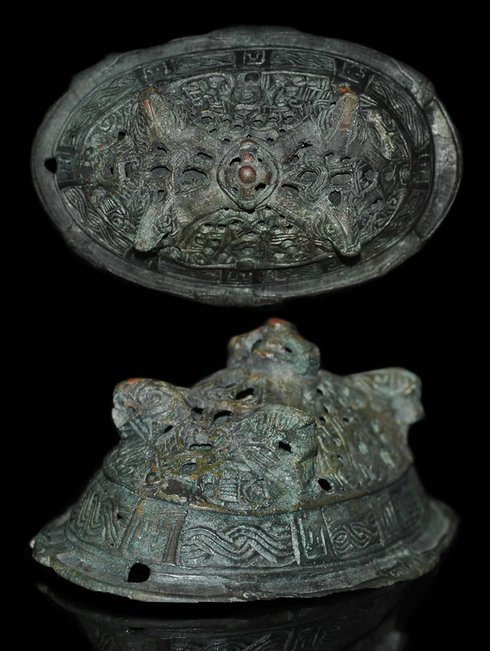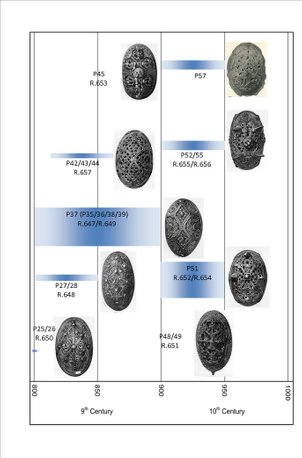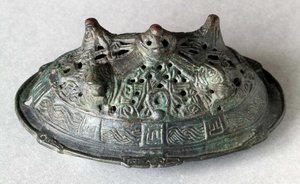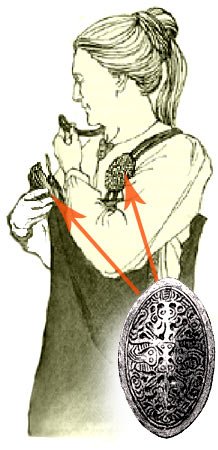The viking tortoise brooch - undoubtly one of the jewel's in
the crown of Viking Age jewellry
In this week's blog I take you with me on a little journey to one of the most outstanding form of art within Viking Age jewellry: the tortoise brooch.
Some years ago I had the luck of my collecting life to be able to aquire one and it is still one of the cornerstones in the collection. At this moment, it is on display on the exhibition 'The Norsemen were here' in the Historiehuis in Roermond (south of Holland) http://www.historiehuis.nl/
Although described in more detail here, I'd like to address this beauty piece of art also in this blog.
Viking tortoise brooches, more in specific, tortoise shell brooches in the beginning were domed and far more 'flat' (as 'flat' is a big word here). The further in time in the Viking Age, the more elaborate and 'outbuild' the tortoises did get. The example I have is from the Petersen's P52/P55 type, wich dates him in the second part of the 10th century.
For years I have thought it was gilded originally, as I have seen on several - the most bling-bling examples who had survived - in the National Museum of Norway in Oslo.
At one day the brooch developed a whitish surface and I consulted an archaeological expert in conserving and cleaning and treating artefacts. The developing white surface happened to be an early phase of bronze disease. Luckily I was just 'in time' treating this piece (see for some general advice to collectors on the page on the object where I have linked to above).
The archeaologist said that this viking tortoise brooch never was gilded. Obviously there were non-gilded and gilded types in the day. In my opinion the use of tortoise brooches may seem to have been widespread, it must have something in use with the more 'upper class' Viking Age woman. A few thousand have been excavated, in more or less complete state. Turning up in antique market just a few times in the last 10 years, addresses their rarity also.
On the images beneath in following order:
- an image of the tortoise, taken in 2009 when I aquired it;
- an image of the diverse types of tortoises brooches during the 9th and 10th century;
- images of the tortoise after treatment (mention the needle wich popped up when all the rust was cleaned away ! Being hollow on the inside and the remaing iron on the inside, it was filled up with a form of plastic to be able to preserve it).
- an image of how the tortoises were worn..
A select reference to books/publications here:
Hammond, Brett, British artefacts Volume 2 - Middle Saxon and Viking (2010) page 40/41, fig. 1.1.3-c.
Jansson, Ingmar, Oval brooches : a study of Viking period standard jewellery based on the finds from Björkö Sweden (1985).
Lonborg, Bjarne. "The method of production of Viking Age tortoise brooches." Kuml 1991-1992. Arhus: I Kommission Hos Aarhus Universitetsforlag. 1991-1992, pp. 151-164.
Rundkvist, Martin, Domed oblong brooches of Vendel Period Scandinavia
Spirgis, Robert, 10th - 13th century Daugava Liv Pectoral Chain Ornaments with Tortoise Brooches (Riga, 2006) see link and image of the book here
A short overview of the types of tortoise brooches in 9th and 10th centuries..
The back of the tortoise brooch after cleaning with a good part of the needle intact.
Well. I could have been with these stones until after dark, but as my wife wanted to travel on.. well.. I see you again, some day, hogback stones from Gosforth. And if you happen to be there one day, do not forget that monument on the outside...
Further on with the Cumbrian hogbacktour !
In - yes, luckily again in - St. Peter's church in Heysham, there is a truly beautiful hogback stone. The guide told us, it had been studyied by Thor Ewing, a writer, in 2000. in 'Understanding the Heysham hogback' A tenth century sculpted stone monument and its context (link), Thor Ewing tells in detail what he dicovered on the both sides of this hogback stone.
Just being brought in the church as late as the 1970's accompanied with some protest here and there among the church visitors, considered as being a token of old paganism, it had been remarkably nice preserved, and a lot of detail can be seen, still. Truly worthwile a visit.
I had a small debate with the guide in the church if the - zoomorphic, in my opinion - faces on the sides were lions (or hippo's). The guide doubted if the vikings could have known about lions. Well I guess so, concerning the runes on the Ancient Greek lion statue at the Arsenal, Venice. For example. Vikings did travel south..
But when he told me he was doubting the vikings 'discovered' (as the native inhabitants were of course, in the first place) America before Columbus, I decided to rest my case..
One has to know when to start and to end a conversation ..
Just discovered the book in a bookstore written by Geoff Holder - The guide to the mysterious Lake District, I knew there had to be another hogback stone in Lowther, St. Micheal's Church. With a promising image described in the text of 'a naval and a land-based force of shield-bearing vikings above a fish and what might be a coiled sea serpent. On the reverse is a row of female figures with snakes, possibly a representation of the hideous hag Hel'. Wow. If that did not sound as a true pagan promised land ..
Not complaing too much after all we have seen, this visit was the dissapointing one of them all. But if you wife states 'I am happy to have seen them' and I am answering 'Measuring is knowing' and the even more obligate verb 'handling 'if we did not see it at all, we wouldn't have known anything at all of how they were looking' the glass was again half full, at the last day of our journey..
The hogback stone appeared to be just being tolerated within the entrance segment part of the church. As something you never use anymore but you do not throw away - entirely. That sort of feeling emerged when seeing this hogback asylum seekers.. Bed, bath and bread, ás we say in Dutch, but no luxury at all and standing on some outcuts of wood, you would balance the table with at home..
Come on, St. Micheal's Church.. care a bit more of your 'children' !
This hogback stone was moved in the church in 1907. Hogback stones layed partially buried in the churchyard before it was dug up and moved into the church.
The promising depiction of a longship - as certainly can be seen after some studying - see http://vikingminds.co.uk/pages/longship
we have missed !
The stone itself is (157 x 50 x 30 cm) and very worn.
The hogback stones in Cumbria - very diverse in quality, but everyone worth a visit ! Especially on a gloomy day in late October ...
The churches to visit - see photos of resp. St. Andrew's church in Penrith, St. Mary's church in Gosforth, St. Peter's church in Heysham and St. Micheal's church in Lowther.
Did I miss out on another one in Cumbria ? Let me know !
In a next blog I will take you to four - still remaining utterly mysterious- statues 'guarding' the graveyard of St. Andrew's church in Dacre..
For the last blog of October 9th see this link.
References: (as always, links to where the books can be ordered are attached).
Edwards, B.J.N. Vikings in North West England - The artifacts (1998);
Emery, Gordon, CURIOUS CUMBRIA, The Lake District & Beyond: A celebration of Cumbria (2023)
Ewing, T. 'Understanding the Heysham hogback' A tenth century sculpted stone monument and its context ;
Hall, R. Viking Age archaeology in Britain and Ireland (first printed 1990, reprinted with amendments in 1995);
Holder, G. The guide to the mysterious Lake District (2009)
possibly also (as there within the part of Cumbria dealing with Carlisle, the Eden Valley, Barrow-in-Furness, Whitehaven and the west coast is being dealed with)
Holder, G. Paranormal Cumbria (2010)
http://vikingminds.co.uk/pages/longship
An image of how the tortoise brooches were being worn. The tortoise on the image is of an earlier 'domed' type. This type is described in more detail here. and here.
It is an example wich was found in Karelia, Finland. One could addres this type as 'Viking-Age Finnic'.
An example of this type was on auction a few years ago. See here.
Finally, take a look at this rare matched pair of oval tortoise brooches who were also on auction a few years ago..
If anyone knows other puiblications on viking tortoise brooches, please let me know at : vikingsandartefacts@yahoo.com
Thomas Kamphuis, May 17th 2015.




